List of governors of Connecticut
The Governor of Connecticut is the elected head of the executive branch of Connecticut's state government, and the commander-in-chief of the state's military forces. The governor has a duty to enforce state laws, and the power to either approve or veto bills passed by the Connecticut General Assembly and to convene the legislature.[3] Unusual among U.S. governors, the Governor of Connecticut has no power to pardon.[4] The Governor of Connecticut is automatically a member of the state's Bonding Commission. He is an ex-officio member of the Board of Trustees of the University of Connecticut and Yale University.
| Governor of Connecticut | |
|---|---|
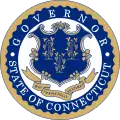 Seal of the Governor | |
| Style | His Excellency |
| Residence | Connecticut Governor's Residence |
| Term length | Four years |
| Inaugural holder | Jonathan Trumbull |
| Deputy | Lieutenant Governor of Connecticut |
| Salary | $150,000 (2013)[1] (Governor Lamont has declined a salary)[2] |
| Website | Office of the Governor |
There have been 68 post-Revolution governors of the state, serving 72 distinct spans in office. Four have served non-consecutive terms: Henry W. Edwards, James E. English, Marshall Jewell, and Raymond E. Baldwin. The longest terms in office were in the state's early years, when four governors were elected to nine or more one-year terms. The longest was that of the first governor, Jonathan Trumbull, who served over 14 years, but 7 of those as colonial governor; the longest-serving state governor — with no other position included in the term — was his son, Jonathan Trumbull Jr., who served over 11 years. The shortest term was that of Hiram Bingham III, who served only one day before resigning to take an elected seat in the U.S. Senate. Lowell Weicker, is noted for a rare third party win in American politics, having been elected to a term in 1990 representing A Connecticut Party.
The current governor is Ned Lamont, a Democrat who took office on January 9, 2019.
Governors
- For the period before independence, see the list of colonial governors of Connecticut.
Connecticut was one of the original Thirteen Colonies and was admitted as a state on January 9, 1788.[5] Before it declared its independence, Connecticut was a colony of the Kingdom of Great Britain.
Connecticut did not create a state constitution for itself until several decades after it became a state; until 1818, the state operated under the provisions of its colonial charter. The charter called for the election of a governor every year, but not more than once every two years, with the term commencing on the second Thursday in May.[6]
The current Constitution of Connecticut, ratified in 1965, calls for a four-year term for the governor,[7] commencing on the Wednesday after the first Monday in the January following an election.[8] The previous constitution of 1818 originally had only a one-year term for governor; this was increased to two years in 1875,[9] and four years in 1948.[10] The 1875 amendment also set the start date of the term to its current date; before then, it was the first Wednesday in the May following an election.[11] The constitution provides for the election of a lieutenant governor for the same term as the governor. The two offices are elected on the same ticket; this provision was added in 1962.[12] In the event of a vacancy in the office of governor, the lieutenant governor becomes governor.[13] Before the adoption of the 1965 constitution, the lieutenant governor only acted as governor.[14] There is no limit of any kind on the number of terms one may serve.
| No.[lower-alpha 2] | Governor | Term in office | Party | Election | Lt. Governor[lower-alpha 3][lower-alpha 4] | |||
|---|---|---|---|---|---|---|---|---|
| 16 |  |
Jonathan Trumbull | 1769 – May 13, 1784 (not candidate for election) |
No party | 1776[lower-alpha 5] | Matthew Griswold | ||
| 1777 | ||||||||
| 1778 | ||||||||
| 1779 | ||||||||
| 1780 | ||||||||
| 1781 | ||||||||
| 1782 | ||||||||
| 1783 | ||||||||
| 17 | Matthew Griswold | May 13, 1784 – May 11, 1786 (lost election)[17] |
Federalist | 1784 | Samuel Huntington | |||
| 1785 | ||||||||
| 18 | 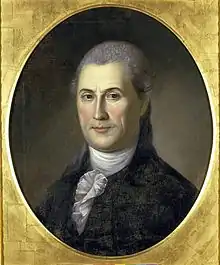 |
Samuel Huntington | May 11, 1786 – January 5, 1796 (died in office) |
Federalist | 1786 | Oliver Wolcott | ||
| 1787 | ||||||||
| 1788 | ||||||||
| 1789 | ||||||||
| 1790 | ||||||||
| 1791 | ||||||||
| 1792 | ||||||||
| 1793 | ||||||||
| 1794 | ||||||||
| 1795 | ||||||||
| 19 |  |
Oliver Wolcott | January 5, 1796 – December 1, 1797 (died in office) |
Federalist | Lieutenant Governor acting as Governor |
Acting as Governor | ||
| 1796 | Jonathan Trumbull Jr. | |||||||
| 1797 | ||||||||
| 20 |  |
Jonathan Trumbull Jr. | December 1, 1797 – August 7, 1809 (died in office) |
Federalist | Lieutenant Governor acting as Governor |
Acting as Governor | ||
| 1798 | John Treadwell | |||||||
| 1799 | ||||||||
| 1800 | ||||||||
| 1801 | ||||||||
| 1802 | ||||||||
| 1803 | ||||||||
| 1804 | ||||||||
| 1805 | ||||||||
| 1806 | ||||||||
| 1807 | ||||||||
| 1808 | ||||||||
| 1809 | ||||||||
| 21 | .jpg.webp) |
John Treadwell | August 7, 1809 – May 9, 1811 (lost election)[18] |
Federalist | Lieutenant Governor acting as Governor |
Acting as Governor | ||
| 1810 | Roger Griswold | |||||||
| 22 | Roger Griswold | May 9, 1811 – October 25, 1812 (died in office) |
Federalist | 1811 | John Cotton Smith | |||
| 1812 | ||||||||
| 23 |  |
John Cotton Smith | October 25, 1812 – May 8, 1817 (lost election) |
Federalist | Lieutenant Governor acting as Governor |
Acting as Governor | ||
| 1813 | Chauncey Goodrich (died August 18, 1815) | |||||||
| 1814 | ||||||||
| 1815 | ||||||||
| Vacant | ||||||||
| 1816 | Jonathan Ingersoll[lower-alpha 6] (died January 12, 1823) | |||||||
| 24 |  |
Oliver Wolcott Jr. | May 8, 1817 – May 2, 1827 (lost election) |
Toleration Republican |
1817 | |||
| 1818 | ||||||||
| 1819 | ||||||||
| 1820 | ||||||||
| 1821 | ||||||||
| 1822 | ||||||||
| Vacant | ||||||||
| 1823 | David Plant[lower-alpha 7] | |||||||
| 1824 | ||||||||
| 1825 | ||||||||
| 1826 | ||||||||
| 25 | .jpg.webp) |
Gideon Tomlinson | May 2, 1827 – March 2, 1831 (resigned)[lower-alpha 8] |
Democratic- Republican |
1827 | John Samuel Peters[lower-alpha 7] | ||
| National Republican | 1828 | |||||||
| 1829 | ||||||||
| 1830 | ||||||||
| 26 | .jpg.webp) |
John Samuel Peters | March 2, 1831 – May 1, 1833 (lost election) |
National Republican |
Lieutenant Governor acting as Governor |
Acting as Governor | ||
| 1831[lower-alpha 9] | Vacant | |||||||
| 1832 | Thaddeus Betts | |||||||
| 27 |  |
Henry W. Edwards | May 1, 1833 – May 7, 1834 (lost election) |
Democratic | 1833 | Ebenezer Stoddard | ||
| 28 |  |
Samuel A. Foot | May 7, 1834 – May 6, 1835 (lost election) |
Whig | 1834 | Thaddeus Betts | ||
| 29 |  |
Henry W. Edwards | May 6, 1835 – May 2, 1838 (not candidate for election) |
Democratic | 1835 | Ebenezer Stoddard | ||
| 1836 | ||||||||
| 1837 | ||||||||
| 30 |  |
William W. Ellsworth | May 2, 1838 – May 4, 1842 (lost election) |
Whig | 1838 | Charles Hawley | ||
| 1839 | ||||||||
| 1840 | ||||||||
| 1841 | ||||||||
| 31 | .jpg.webp) |
Chauncey Fitch Cleveland | May 4, 1842 – May 1, 1844 (lost election) |
Democratic | 1842 | William S. Holabird | ||
| 1843 | ||||||||
| 32 |  |
Roger Sherman Baldwin | May 1, 1844 – May 6, 1846 (not candidate for election) |
Whig | 1844 | Reuben Booth | ||
| 1845 | ||||||||
| 33 |  |
Isaac Toucey | May 6, 1846 – May 5, 1847 (not candidate for election) |
Democratic | 1846 | Noyes Billings | ||
| 34 |  |
Clark Bissell | May 5, 1847 – May 2, 1849 (not candidate for election) |
Whig | 1847 | Charles J. McCurdy | ||
| 1848 | ||||||||
| 35 |  |
Joseph Trumbull | May 2, 1849 – May 4, 1850 (not candidate for election) |
Whig | 1849 | Thomas Backus | ||
| 36 |  |
Thomas H. Seymour | May 4, 1850[lower-alpha 10] – October 13, 1853 (resigned)[lower-alpha 11] |
Democratic | 1850 | Charles H. Pond | ||
| 1851 | Green Kendrick | |||||||
| 1852 | Charles H. Pond | |||||||
| 1853 | ||||||||
| 37 | .jpg.webp) |
Charles H. Pond | October 13, 1853 – May 3, 1854 (not candidate for election) |
Democratic | Lieutenant Governor acting as Governor |
Acting as Governor | ||
| 38 | .jpg.webp) |
Henry Dutton | May 3, 1854 – May 2, 1855 (lost election) |
Whig | 1854 | Alexander H. Holley | ||
| 39 | 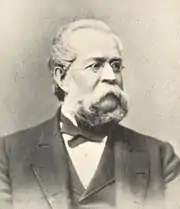 |
William T. Minor | May 2, 1855 – May 6, 1857 (not candidate for election) |
American | 1855 | William Field | ||
| 1856 | Albert Day | |||||||
| 40 | .jpg.webp) |
Alexander H. Holley | May 6, 1857 – May 5, 1858 (not candidate for election) |
Republican | 1857 | Alfred A. Burnham | ||
| 41 | .jpg.webp) |
William Alfred Buckingham | May 5, 1858 – May 2, 1866 (not candidate for election) |
Republican | 1858 | Julius Catlin | ||
| 1859 | ||||||||
| 1860 | ||||||||
| 1861 | Benjamin Douglas | |||||||
| 1862 [lower-alpha 12] | Roger Averill | |||||||
| 1863 | ||||||||
| National Union | 1864 | |||||||
| 1865 | ||||||||
| 42 | 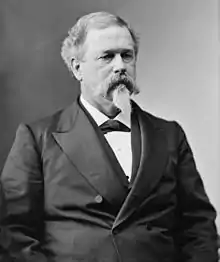 |
Joseph Roswell Hawley | May 2, 1866 – May 1, 1867 (lost election) |
Republican | 1866 | Oliver Winchester | ||
| 43 |  |
James E. English | May 1, 1867 – May 5, 1869 (lost election) |
Democratic | 1867 | Ephraim H. Hyde | ||
| 1868 | ||||||||
| 44 | 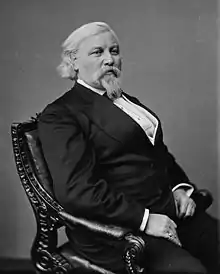 |
Marshall Jewell | May 5, 1869 – May 4, 1870 (lost election) |
Republican | 1869 | Francis Wayland III | ||
| 45 |  |
James E. English | May 4, 1870 – May 16, 1871 (lost election)[lower-alpha 13] |
Democratic | 1870 | Julius Hotchkiss | ||
| 46 |  |
Marshall Jewell | May 16, 1871 – May 7, 1873 (not candidate for election) |
Republican | 1871[lower-alpha 13] | Morris Tyler | ||
| 1872 | ||||||||
| 47 | .jpg.webp) |
Charles Roberts Ingersoll | May 7, 1873 – January 3, 1877 (not candidate for election) |
Democratic | 1873 | George G. Sill | ||
| 1874 | ||||||||
| 1875[lower-alpha 14] | ||||||||
| April 1876[lower-alpha 15] | ||||||||
| 48 | .jpg.webp) |
Richard D. Hubbard | January 3, 1877 – January 9, 1879 (lost election) |
Democratic | November 1876[lower-alpha 16] | Francis Loomis | ||
| 49 | .jpg.webp) |
Charles B. Andrews | January 9, 1879[lower-alpha 17] – January 5, 1881 (not candidate for election) |
Republican | 1878 | David Gallup | ||
| 50 | .jpg.webp) |
Hobart B. Bigelow | January 5, 1881 – January 3, 1883 (not candidate for election) |
Republican | 1880 | William H. Bulkeley | ||
| 51 | .jpg.webp) |
Thomas M. Waller | January 3, 1883 – January 8, 1885 (lost election) |
Democratic | 1882 | George G. Sumner | ||
| 52 | .jpg.webp) |
Henry Baldwin Harrison | January 8, 1885[lower-alpha 18] – January 7, 1887 (not candidate for election) |
Republican | 1884 | Lorrin A. Cooke | ||
| 53 | .jpg.webp) |
Phineas C. Lounsbury | January 7, 1887[lower-alpha 19] – January 10, 1889 (not candidate for election) |
Republican | 1886 | James L. Howard | ||
| 54 |  |
Morgan Bulkeley | January 10, 1889[lower-alpha 20] – January 4, 1893 (not candidate for election) |
Republican | 1888 | Samuel E. Merwin | ||
| 1890[lower-alpha 21] | ||||||||
| 55 | .jpg.webp) |
Luzon B. Morris | January 4, 1893 – January 9, 1895 (not candidate for election) |
Democratic | 1892 | Ernest Cady | ||
| 56 | .jpg.webp) |
Owen Vincent Coffin | January 9, 1895 – January 6, 1897 (not candidate for election) |
Republican | 1894 | Lorrin A. Cooke | ||
| 57 | .jpg.webp) |
Lorrin A. Cooke | January 6, 1897 – January 4, 1899 (not candidate for election) |
Republican | 1896 | James D. Dewell | ||
| 58 |  |
George E. Lounsbury | January 4, 1899 – January 9, 1901 (not candidate for election) |
Republican | 1898 | Lyman A. Mills | ||
| 59 |  |
George P. McLean | January 9, 1901 – January 7, 1903 (not candidate for election) |
Republican | 1900 | Edwin O. Keeler | ||
| 60 | .jpg.webp) |
Abiram Chamberlain | January 7, 1903 – January 4, 1905 (not candidate for election) |
Republican | 1902 | Henry Roberts | ||
| 61 | .jpg.webp) |
Henry Roberts | January 4, 1905 – January 9, 1907 (not candidate for election) |
Republican | 1904 | Rollin S. Woodruff | ||
| 62 | .jpg.webp) |
Rollin S. Woodruff | January 9, 1907 – January 6, 1909 (not candidate for election) |
Republican | 1906 | Everett J. Lake | ||
| 63 |  |
George L. Lilley | January 6, 1909 – April 21, 1909 (died in office) |
Republican | 1908 | Frank B. Weeks | ||
| 64 | .jpg.webp) |
Frank B. Weeks | April 21, 1909 – January 4, 1911 (not candidate for election) |
Republican | Lieutenant Governor acting as Governor |
Acting as Governor | ||
| 65 |  |
Simeon Eben Baldwin | January 4, 1911 – January 6, 1915 (not candidate for election) |
Democratic | 1910 | Dennis A. Blakeslee[lower-alpha 22] | ||
| 1912 | Lyman T. Tingier | |||||||
| 66 | .jpg.webp) |
Marcus H. Holcomb | January 6, 1915 – January 5, 1921 (not candidate for election) |
Republican | 1914 | Clifford B. Wilson | ||
| 1916 | ||||||||
| 1918 | ||||||||
| 67 | .jpg.webp) |
Everett J. Lake | January 5, 1921 – January 3, 1923 (not candidate for election) |
Republican | 1920 | Charles A. Templeton | ||
| 68 | .jpg.webp) |
Charles A. Templeton | January 3, 1923 – January 7, 1925 (not candidate for election) |
Republican | 1922 | Hiram Bingham III | ||
| 69 |  |
Hiram Bingham III | January 7, 1925 – January 8, 1925 (resigned)[lower-alpha 23] |
Republican | 1924 | John H. Trumbull | ||
| 70 | John H. Trumbull | January 8, 1925 – January 7, 1931 (not candidate for election) |
Republican | Lieutenant Governor acting as Governor |
Acting as Governor[lower-alpha 24] | |||
| 1926 | J. Edwin Brainard | |||||||
| 1928 | Ernest E. Rogers | |||||||
| 71 | 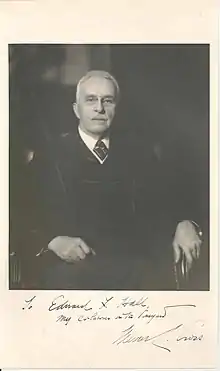 |
Wilbur Lucius Cross | January 7, 1931 – January 4, 1939 (lost election) |
Democratic | 1930 | Samuel R. Spencer[lower-alpha 22] | ||
| 1932 | Roy C. Wilcox[lower-alpha 22] | |||||||
| 1934 | T. Frank Hayes | |||||||
| 1936 | ||||||||
| 72 |  |
Raymond E. Baldwin | January 4, 1939 – January 8, 1941 (lost election) |
Republican | 1938 | James L. McConaughy | ||
| 73 | Robert A. Hurley | January 8, 1941 – January 6, 1943 (lost election) |
Democratic | 1940 | Odell Shepard | |||
| 74 |  |
Raymond E. Baldwin | January 6, 1943 – December 27, 1946 (resigned)[lower-alpha 25] |
Republican | 1942 | William L. Hadden | ||
| 1944 | Charles Wilbert Snow[lower-alpha 26] | |||||||
| 75 | Charles Wilbert Snow | December 27, 1946 – January 8, 1947 (successor took office) |
Democratic | Lieutenant Governor acting as Governor |
Acting as Governor | |||
| 76 | James L. McConaughy | January 8, 1947 – March 7, 1948 (died in office) |
Republican | 1946 | James C. Shannon | |||
| 77 | James C. Shannon | March 7, 1948 – January 5, 1949 (lost election) |
Republican | Lieutenant Governor acting as Governor |
Acting as Governor[lower-alpha 27] | |||
| 78 | .jpg.webp) |
Chester Bowles | January 5, 1949 – January 3, 1951 (lost election) |
Democratic | 1948 | William T. Carroll | ||
| 79 |  |
John Davis Lodge | January 3, 1951 – January 5, 1955 (lost election) |
Republican | 1950[lower-alpha 28] | Edward N. Allen | ||
| 80 |  |
Abraham Ribicoff | January 5, 1955 – January 21, 1961 (resigned)[lower-alpha 29] |
Democratic | 1954 | Charles W. Jewett | ||
| 1958 | John N. Dempsey | |||||||
| 81 |  |
John N. Dempsey | January 21, 1961 – January 6, 1971 (not candidate for election) |
Democratic | Lieutenant Governor acting as Governor |
Acting as Governor[lower-alpha 30] | ||
| 1962 | Samuel J. Tedesco (resigned January 15, 1966) | |||||||
| Fred J. Doocy | ||||||||
| 1966 | Attilio R. Frassinelli | |||||||
| 82 | .png.webp) |
Thomas Meskill | January 6, 1971 – January 8, 1975 (not candidate for election) |
Republican | 1970 | T. Clark Hull (resigned June 1, 1973) | ||
| Peter L. Cashman | ||||||||
| 83 | 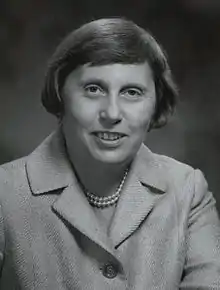 |
Ella Grasso | January 8, 1975 – December 31, 1980 (resigned)[lower-alpha 31] |
Democratic | 1974 | Robert K. Killian | ||
| 1978 | William A. O'Neill | |||||||
| 84 | William A. O'Neill | December 31, 1980 – January 9, 1991 (not candidate for election) |
Democratic | Succeeded from Lieutenant Governor |
Joseph J. Fauliso | |||
| 1982 | ||||||||
| 1986 | ||||||||
| 85 | 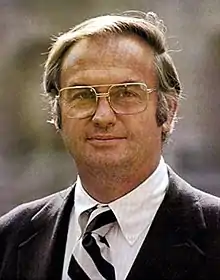 |
Lowell Weicker | January 9, 1991 – January 4, 1995 (not candidate for election) |
A Connecticut Party | 1990 | Eunice Groark | ||
| 86 | .jpg.webp) |
John G. Rowland | January 4, 1995 – July 13, 2004 (resigned)[lower-alpha 32] |
Republican | 1994 | Jodi Rell | ||
| 1998 | ||||||||
| 2002 | ||||||||
| 87 |  |
Jodi Rell | July 13, 2004 – January 5, 2011 (not candidate for election) |
Republican | Succeeded from Lieutenant Governor |
Kevin Sullivan[lower-alpha 26] | ||
| 2006 | Michael Fedele | |||||||
| 88 | 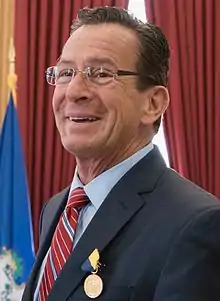 |
Dannel Malloy | January 5, 2011 – January 9, 2019 (not candidate for election) |
Democratic | 2010 | Nancy Wyman | ||
| 2014 | ||||||||
| 89 | .jpg.webp) |
Ned Lamont | January 9, 2019 – present[lower-alpha 33] |
Democratic | 2018 | Susan Bysiewicz | ||
Succession
Notes
- Data is sourced from the National Governors Association, unless supplemental references are required.
- According to the Connecticut State Library, the official listing goes back to the first governor of Connecticut Colony in 1639, and did not include repeat governors serving non-consecutive terms in the colonial period; this makes Trumbull the 16th governor.[15] The official numbering since statehood includes repeat and acting governors.
- The office of Lieutenant Governor was known as Deputy-Governor under the colonial charter, but the name 'Lieutenant Governor' was predominantly used after independence.[6]
- Lieutenant governors represented the same party as their governor unless noted.
- The Connecticut General Assembly approved the United States Declaration of Independence on October 10, 1776, and resolved that the state's government would continue as established under the charter. So, as colonial governor, Jonathan Trumbull became state governor, serving roughly 14 years total.[16]
- Represented the Democratic-Republican Party until 1817, and the Toleration Party after that.
- Represented the National Republican Party
- Tomlinson resigned to take an elected seat in the United States Senate.[19]
- John Samuel Peters became Acting Governor on March 2, 1831 following the resignation of Gideon Tomlinson. It was too close to the April election to nominate a Lieutenant Governor, so the office remained vacant for one year.
- The constitutional start date for the term in 1850 was May 1; the delay may be because Seymour was chosen by the legislature after a close election.[20]
- Seymour resigned to be U.S. Minister to Russia.[20]
- Separate Unionist and Republican conventions held in January 1862 endorsed a fusion ticket of Republicans and War Democrats. The Democratic Party endorsed their own ticket. The Unionist/Republican ticket included Republican Buckingham and War Democrat Averill, and would win the election.
- James English won the popular vote, but a canvassing committee found the election was fraudulent, and named Jewell governor several days into the term.[21]
- This term was lengthened by nearly 8 months due to a constitutional amendment moving the election schedule.[9]
- This term was only from May 1876 to January 1877, due to a constitutional amendment moving the election schedule.[9]
- First election in November, and first term under a constitutional amendment which lengthened terms to two years.[9]
- The constitutional start date for the term in 1879 was January 8; the delay may be because Andrews was chosen by the legislature after a close election.[22][23]
- The constitutional start date for the term in 1885 was January 7; the delay may be because Harrison was chosen by the legislature after a close election.[24]
- The constitutional start date for the term in 1887 was January 5; the delay may be because Lounsbury was chosen by the legislature after a close election.[25]
- The constitutional start date for the term in 1889 was January 9; the delay may be because Bulkeley was chosen by the legislature after a close election.[26]
- Morgan Bulkeley did not run for re-election in 1890, but due to such a close contest and controversies, the results were not certified, and the legislature spent two years debating the issue; Bulkeley essentially served as governor by default.[26]
- Represented the Republican Party
- Bingham resigned to take an elected seat in the United States Senate.[27]
- Since Trumbull took over only one day into the term, nearly all sources describe J. Edwin Brainard as lieutenant governor during this term; however, constitutionally, he would have remained president of the senate and only acted as lieutenant governor. At least one contemporary news source describes him as such.[28]
- Baldwin resigned to take an elected seat in the United States Senate.[29]
- Represented the Democratic Party
- Robert E. Parsons is always listed as serving as lieutenant governor during this term, but constitutionally he likely would have remained president of the senate. However, questions were raised over whether or not they should fully succeed to the next office.[30]
- First term under a constitution amendment which lengthened terms to four years.[10]
- Ribicoff resigned to become United States Secretary of Health, Education, and Welfare.[31]
- Anthony J. Armentano is always listed as serving as lieutenant governor during this term, but constitutionally he likely would have remained president of the senate. This is the last time such a confusion would exist, as the 1965 constitution established a solid line of succession.
- Grasso resigned due to ovarian cancer.[32]
- Rowland resigned due to a federal corruption investigation;[33] he later pleaded guilty to corruption.[34]
- Lamont's first term expires on January 4, 2023.
References
- General
- "Governors of Connecticut". National Governors Association. Retrieved July 10, 2019.
- "Roster of Connecticut Governors". Connecticut State Library. Retrieved December 15, 2018.
- Loomis, Dwight; Joseph Gilbert Calhoun (1895). The Judicial and Civil History of Connecticut. The Boston History Company. pp. 114–117. Retrieved August 4, 2010.
- Sobel, Robert (1978). Biographical directory of the governors of the United States, 1789-1978, Vol. I. Meckler Books. ISBN 9780930466015. Retrieved July 10, 2019.
- Constitutions
- "Constitution of the State of Connecticut". Connecticut State Library. 1965. Archived from the original on March 23, 2009. Retrieved February 21, 2009.
- "Constitution of the State of Connecticut". Secretary of the State of Connecticut. 1818. Archived from the original on 2009-04-22. Retrieved February 21, 2009.
- "Charter of the Colony of Connecticut". National Humanities Institute. 1662. Retrieved February 21, 2009.
- Specific
- "CSG Releases 2013 Governor Salaries". The Council of State Governments. June 25, 2013. Retrieved November 23, 2014.
- "When it comes to giving at the office, Gov. Lamont is writing checks and not taking a salary". The Hartford Courant. July 7, 2019. Retrieved April 4, 2020.
- CT Const. art. IV
- "Pardons Power in Connecticut". Archived from the original on June 13, 2008. Retrieved June 13, 2008.
- "Today in History: January 9". Library of Congress. Retrieved February 21, 2009.
- 1662 Charter
- CT Const. art. IV, § 1
- CT Const. art. IV, § 2
- 1818 Const. amendment XVI
- 1818 Const. amendment XLV
- 1818 Const. art. IV § 1
- 1818 Const. new amendment VII
- CT Const. art. IV § 19
- 1818 Const. art. IV § 14
- "Roster of Connecticut Governors". Connecticut State Library. Retrieved April 4, 2008.
- "Jonathan Trumbull". Connecticut State Library. Archived from the original on 2008-12-26. Retrieved 2009-03-10.
- "Matthew Griswold". Connecticut State Library. Retrieved December 15, 2018.
- "John Treadwell". Connecticut State Library. Retrieved December 17, 2018.
- "Gideon Tomlinson". National Governors Association. Retrieved July 10, 2019.
- "Thomas H. Seymour". National Governors Association. Retrieved July 10, 2019.
- "James Edward English". National Governors Association. Retrieved July 10, 2019.
- "Charles Bartlett Andrews". National Governors Association. Retrieved July 10, 2019.
- "Governor Andrews' First Message". New York Herald. New York City. January 10, 1879. Retrieved December 19, 2018.
- "Henry Baldwin Harrison". National Governors Association. Retrieved July 10, 2019.
- "Phineas Chapman Lounsbury". National Governors Association. Retrieved July 10, 2019.
- "Morgan Gardner Bulkeley". National Governors Association. Retrieved July 10, 2019.
- "Hiram Bingham". National Governors Association. Retrieved July 10, 2019.
- "Unknown title". Hartford Courant. Hartford, Connecticut. January 11, 1925. Retrieved December 18, 2018.
Acting Lieutenant-Governor Brainard, once a foundry hand...
- "Raymond Early Baldwin". National Governors Association. Retrieved July 10, 2019.
- "Doubt Cast on Parsons's Right to Title". Hartford Courant. Hartford, Connecticut. March 31, 1948. Retrieved December 18, 2018.
- "Abraham Alexander Ribicoff". National Governors Association. Retrieved July 10, 2019.
- "Ella T. Grasso". National Governors Association. Retrieved July 10, 2019.
- William Yardley; Stacey Stowe; Avi Salzman and Alison Leigh Cowan (June 22, 2004). "Connecticut's Governor Steps Down". The New York Times.CS1 maint: uses authors parameter (link)
- Robert D. McFadden (December 24, 2004). "An Ex-Governor Says He's Guilty". The New York Times.
External links
| Wikimedia Commons has media related to Governors of Connecticut. |

